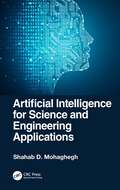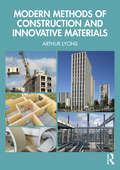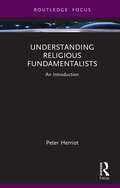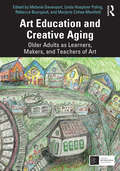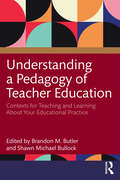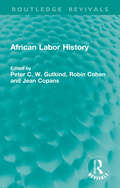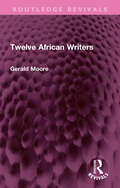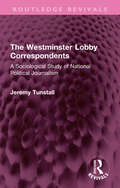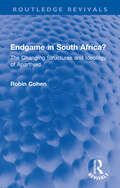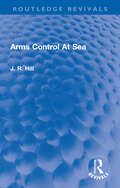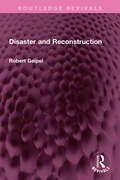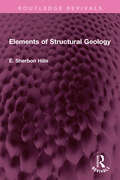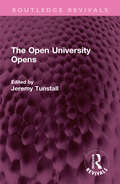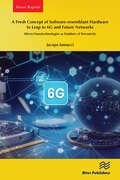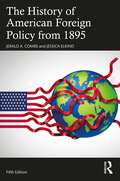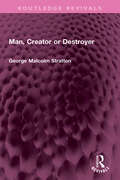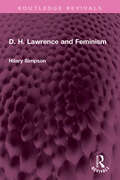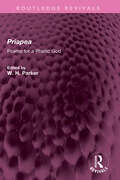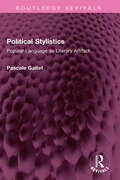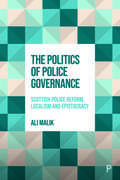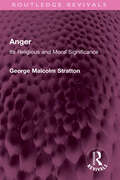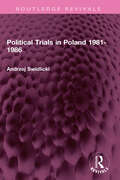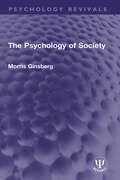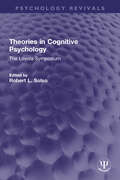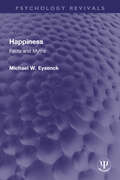- Table View
- List View
Artificial Intelligence for Science and Engineering Applications
by Shahab D. MohagheghArtificial Intelligence (AI) is defined as the simulation of human intelligence through the mimicking of the human brain for analysis, modeling, and decision‑making. Science and engineering problem solving requires modeling of physical phenomena, and humans approach the solution of scientific and engineering problems differently from other problems. Artificial Intelligence for Science and Engineering Applications addresses the unique differences in how AI should be developed and used in science and engineering. Through the inclusion of definitions and detailed examples, this book describes the actual and realistic requirements as well as what characteristics must be avoided for correct and successful science and engineering applications of AI.This book:• Offers a brief history of AI and covers science and engineering applications• Explores the modeling of physical phenomena using AI• Discusses explainable AI (XAI) applications• Covers the ethics of AI in science and engineering• Features real‑world case studiesOffering a probing view into the unique nature of scientific and engineering exploration, this book will be of interest to generalists and experts looking to expand their understanding of how AI can better tackle and advance technology and developments in scientific and engineering disciplines.
Modern Methods of Construction and Innovative Materials
by Arthur LyonsThis new textbook has two main themes. The first is Modern Methods of Construction (MMC) which is the off-site manufacture of a wide spectrum of products, ranging from whole buildings to be transported onto site, down to smaller units or components for site integration. The second theme describes the innovation and progress towards carbon zero by the major generators of CO2 in the construction industry – namely cement, steel and masonry.The first section of the book describes and illustrates with photographs, the major forms of Modern Methods of Construction. These include fully completed 3D units, panelised systems, pods, sub-assemblies and on-site MMC. The section on Innovative Materials then describes a wide range of construction products which are entering into the built environment sector. Some new entrants are variants on well-established construction materials such as steel and concrete. Materials such as these will remain major construction materials for the foreseeable future, but their composition and manufacturing processes will inevitably have to change. Timber also will remain a major construction material, but sustainable sourcing is key and its utilisation as cross-lamination timber (CLT) or as modified timber is rapidly developing. As a result, students and practitioners must familiarise themselves with these materials, their composition, and various uses.The book goes on to describe variants of other traditional building products, such as glass, plastic and insulation, which are undergoing major developments leading towards enhanced environmental sustainability, as well as many emergent materials, some of which are likely to be significant in future. Modern Methods of Construction and Innovative Materials is the only book combining these important elements of the future of the industry in an easy-to-read guide for students and new practitioners. It is essential reading for anyone studying and working in the built environment, be they architects, construction managers, surveyors or engineers.
Understanding Religious Fundamentalists: An Introduction (Routledge Focus on Religion)
by Peter HerriotThis book introduces the prominent role that fundamentalists play in religious, cultural, and political arenas.It begins by investigating religious fundamentalist groups and their psychological motivations for this counter-cultural adherence. Their extremely varied actions, argues the author, are based on two fundamental beliefs: that God speaks to them personally through his Word; and that they are involved in a cosmic war between God and Satan.. Subsequent chapters explore how fundamentalisms meet universal psychological needs for meaning, identity, agency, and self-esteem. Moving from individual psychology to social context, the latter half of the book explores how fundamentalist movements derive and exercise their authority and how leaders may strategise to appeal to external societies. The closing chapters seek to place the growth of fundamentalisms and their continued popularity in the social context of modernity and populism.With engaging discussion questions and suggestions for further reading, this book is ideal for students of social science and religion, as well as readers interested in the psychological roots of fundamentalism.
Art Education and Creative Aging: Older Adults as Learners, Makers, and Teachers of Art
by Melanie Davenport Linda Hoeptner Poling Rébecca Bourgault Marjorie Cohee ManifoldThis text explores how art education can meaningfully address the needs of older adults as learners, makers, and teachers of art in formal and informal settings. It combines perspectives of museum educators, teacher preparation professors, art therapists, teaching artists, and older artists on what is meant by Creative Aging and the ways art education can support the health and well-being of this population. Most importantly, the book discusses what the field of art education can gain from older adult learners and creators.Chapters are organized into five sections: Creatively Aging, Meeting Older Adults’ Unique Needs, Intergenerational Art Education, Engaging Older Adults With Artworks and Objects, and In Our Own Voices: Older Adults as Learners, Makers, and Teachers. Within each section, contributors investigate themes critical to art education within aging populations such as memory loss, disability, coping with life transitions, lifelong learning, intergenerational relationships, and personal narrative. The final section focuses on accounts from older adult artists/educators, offering insights and proposing new directions for growing older creatively.Though ideal for art education faculty and students in graduate and undergraduate settings, as well as art education scholars and those teaching in multigenerational programs within community settings, this book is an expansive resource for any artist, student, or scholar interested in the links among health, well-being, and arts participation for older adults.
Understanding a Pedagogy of Teacher Education: Contexts for Teaching and Learning About Your Educational Practice
by Brandon M. Butler Shawn Michael BullockProviding readers with insights and examples of how teacher educators learn and teach a pedagogy of teacher education (PTE), Butler and Bullock organize a wholistic and practical resource for the next generation of teacher educators. Expanding on the highly referenced scholarship of John Loughran and Tom Russell, Understanding a Pedagogy of Teacher Education explores the learning of PTE through individual and collaborative endeavors, and large-scale institutional and cross-national initiatives. Contributors highlight their experiences teaching PTE in formal learning spaces, in international workshop settings, and on the program-wide scale in order to uncover how they came to understand PTE and enact it effectively. Each chapter connects broad strokes concepts of PTE to well-defined teacher education fields, such as social justice, literacy, early childhood education, and communities of practice. Blending well- established theory with contemporary examples, this book is a great tool for teacher education faculty, doctoral students, and those interested in improving their PTE or supporting others in their PTE learning.
African Labor History (Routledge Revivals)
by Peter C.W. Gutkind Robin Cohen Jean CopansOriginally published in 1978, this book was distinctive in translating the work of French labour specialists and includes chapters on Nigeria, South Africa, Senegal, Kenya, Tanganyika, Madagascar and Botswana. Although all the papers are set in historically specific events, some of the larger issues receive further treatment. These concern the reality of the existence of an African working class and its class identity and consciousness. Each contributor adds to the debate by means of demonstrating how African workers have responded to their work situation, to deprivation and exploitation, and to the political authority of the colonial or neocolonial state
Twelve African Writers (Routledge Revivals)
by Gerald MooreOriginally published in 1980, this book introduces the student to twelve of the most exciting and significant African authors of the 20th Century, whose work represents Anglophone and Francophone writing (with translation) drawn from West, East and Southern Africa. Twelve African Writers was a revised, updated and extended edition of the pioneering Seven African Writers which did so much to make students aware of African literature. The book also contains an extensive bibliography of the works not just of the selected writers, but other important African authors and recommendations of further critical works.
The Westminster Lobby Correspondents: A Sociological Study of National Political Journalism (Routledge Revivals)
by Jeremy TunstallThe Westminster Lobby correspondents have a special place in both the politics and the mass media of Britain. These journalists dominate the behind-the-scenes reporting of British national politics. In this book, originally published in 1970, Jeremy Tunstall presents the first systematic social science study of the uniquely British phenomenon of Lobby correspondents.The study includes data collected from interviews with the national Lobby correspondents, who also completed lengthy questionnaires. It contains evidence of their careers, political opinions, pay, working conditions, relationships with their employing news organization and political news sources, and on the way in which the correspondents both compete with, and exchange information with, each other. As well as this fascinating empirical data, the book offers an important contribution to the sociology of politics and the mass media, and to the study of ‘organizational intelligence’ and the sociology of occupations.There had long centred upon the Lobby correspondents many myths and misconceptions, which Jeremy Tunstall effectively demolishes. (The so-called ‘Lobby rules’ were here published for the first time.) Other real dilemmas are, however, revealed: the competing demands of publicity and secrecy; the dilemmas of British politics in which basic principles – such as Parliamentary supremacy and Cabinet secrecy – are daily breached, not only by the correspondents, but also by leading politicians; and the problems of a system of political communication whose obsession with daily news values is so similar to official and academic contributions. With media and politics still very much linked today, this reissue can be read and enjoyed in its historical context.
Endgame in South Africa?: The Changing Structures and Ideology of Apartheid (Routledge Revivals)
by Robin CohenThe white monopoly of political power; the attempt to make race coincide with space; the regulation of the labour supply; the maintenance of social control. Originally published in 1986 and now reissued with a new preface by Robin Cohen, this book acknowledges that the above are the four pillars of apartheid and asks if white political power were dislodged whether the other three pillarswould crumble. This is a concise book which evaluated social and political change in South Africa at a key moment in the nation’s history and which assesses the limits and possibilities of ideological adaptation
Arms Control At Sea (Routledge Revivals)
by J Richard HillOriginally published in 1989, this book reviews the history of maritime control measures from before the First World War and provides a critical examination of both the objectives of maritime power and the concepts of disarmament, peace zones, parity, verifiability and peaceful co-existence. It argues that the objectives or maritime power are not necessarily incompatible with international security and that strategic deterrence can contribute to improved security. Limitation measures, it is argued, can in some cases be double-edged, endangering other security fields and having a destabilizing effect. The book stresses the need for non-absolute solutions in order to achieve a reasonable level of security and makes proposals for both structural and confidence-building measures along those lines
Disaster and Reconstruction (Routledge Revivals)
by R GeipelOriginally published in 1982 and based on empirical research into the aftermath of the Friuli earthquake in Italy, the book reflects the perspective gained over a period of four years on the event itself and the subsequent response of the local population and national government. Unique insights were gained through one of the largest questionnaire surveys ever undertaken in a disaster situation and important questions are posed concerning the policies of reconstruction. Is a disaster ‘the great equalizer’ and does regional society emerge from it with redistributed power relationships, or are established structures reinforced? Who gets hurt and who benefits? What effects do poverty, regional remoteness from central government and the ethnic and cultural dimensions have on the situation? As a substantial treatment of a major catastrophe in all its aspects, this book will be of interest to students and researchers concerned with the impact of and response to natural hazards. It is based on a unique event, but the findings it reveals are relevant to all major catastrophes.
Elements of Structural Geology (Routledge Revivals)
by E. Sherbon HillsOriginally published in 1963, this classic textbook was revised fully for the 1972 edition. The author presents a comprehensive account of all topics falling within the domain of structural geology in his characteristically objective, scientific and logical manner. The book pays particular attention to definitions and the origin of terms. Geology is a global science and this book used examples and ideas from work in many countries. The book is comprehensive in scope, dealing not only with secondary structures and tectonics, but also with primary structures of secondary and igneous rocks. This was the first textbook to deal with rock material as two-phase systems rather than as solids and this approach is continued in this reissued edition by analysis of concepts such as ocean-floor spreading and plate tectonics
The Open University Opens (Routledge Revivals)
by Jeremy TunstallStill going strong today, The Open University, Britain’s national correspondence – TV – radio University, excited much controversy when it first opened and in 1973 awarded its first degrees. With its adult, part-time students, its freedom from formal entrance qualifications, it deliberately questioned many orthodoxies of higher education at the time. Yet the OU differed so much from other universities that few outsiders grasped quite how complex, quite how revolutionary, quite how downright infuriating the OU was, or could be.Originally published in 1974, this book gives a first-hand account of what the OU was about and what it felt like to be an OU student or lecturer. The articles in the collection – edited by Jeremy Tunstall, himself on the OU staff – include contributions from outside observers, from OU staff, and from OU students. This is an unofficial yet informed and lively account of what it felt like in 1974, and what it felt like in the early days, to be part of a project so controversial and progressive.
A Fresh Concept of Software-resemblant Hardware to Leap to 6G and Future Networks: Micro/Nanotechnologies as Enablers of Pervasivity
by Jacopo IannacciFor a decade, with the uptake of 4G, we have become accustomed to the relentless increase in data and services on the move. The deployment of 5G is advancing crucial key performance indicators (KPIs), along with quality of service (QoS). Setting the horizon to 2030 and later, 6G will take the KPIs to numbers 100–1000 times better than 5G. Yet, the actual disruption of 6G and future networks (FN) will take place following other unprecedented paths.Artificial intelligence (AI) will be exploited in a threadlike fashion, at any level of the network physical infrastructure. This will introduce, to date unknown features, like self-sustaining, self-evolution and high-resilience of small portions of the infrastructure, pioneering the concept of a network of networks. Each segment of the infrastructure will bear a high degree of independence, while working at the same time as a whole, in full orchestration with the rest of the network.Given such a scenario, this book claims that the established and currently in use paradigms for the design and development of hardware–software (HW–SW) systems, are not appropriate to address the challenges of 6G and, further ahead, of FN. In response, unprecedented design approaches are suggested, relying on a fresh reinterpretation of the standard concept of HW, with specific attention to the network edge and edge intelligence (EI).This work develops some conceptual tools that may help address the technical challenges resulting from the intricate scenario sketched above. Within the mentioned HW reconceptualization, a pivotal role is forecasted for microtechnologies and nanotechnologies, intended with a broad meaning, which embraces, among others, devices, systems (MEMS/NEMS) and materials.
The History of American Foreign Policy from 1895 (xx xx)
by Jerald A. Combs Jessica ElkindNow in its fifth edition, this volume offers a clear, concise, and nuanced history of U.S. foreign relations since the Spanish–American War and places that narrative within the context of the most influential historiographical trends and debates.The History of American Foreign Policy from 1895 includes both revised and new sections that incorporate insights from recent scholarship on the United States in the world. These sections devote more attention to the international framework as well as the domestic constraints under which American foreign policymakers operated. This edition also emphasizes the role of non-state actors such as missionaries, aid workers, activists, and business leaders in shaping policies and contributing to international relations. As a result, the text considers a broader and more diverse range of people and voices than many other histories of U.S. foreign policy. Expanded final chapters bring the story of U.S. foreign relations to the present and explore some of the contemporary challenges facing American and global leaders, including terrorism, the effects of climate change, China’s increasing influence, and globalization. Updated controversial issues sections and suggestions for further reading at the end of each chapter reflect important contributions from new studies.This engaging text is an invaluable resource for students interested in the history of American foreign policy and international relations.
Man, Creator or Destroyer (Routledge Revivals)
by George Malcolm StrattonFirst published in 1952, Man, Creator or Destroyer makes clear that mankind is preeminent both as a creator and as a destroyer. And we are doomed unless creative man can master destructive man. But how gain this mystery? How strengthen the one and weaken the other? This and other vital questions are answered clearly for the general reader interested in creative work, from art and science to crime-prevention and international statecraft. The first part is concerned with man’s creative power which distinguishes him from all else on earth and suggests that man is much more than a machine or an animal. In the second part attention moves to man’s destructive power and studies his inclination to obstruct and shatter his own constructive work. The book concludes with an examination of the ways in which the creative power can gain the mastery.
D. H. Lawrence and Feminism (Routledge Revivals)
by Hilary SimpsonFirst published in 1982, D. H. Lawrence and Feminism discusses Lawrence’s work by examining it in relation to aspects of women’s history and the development of feminism. Two different modes of pre-war feminism which provide important themes in Lawrence’s early writings are examined in the opening chapters. The central chapters deal with the war, both as a catalyst for major changes in the position of women and as a point of no return in the development of Lawrence’s work. A final chapter looks at the way in which Lawrence used women as collaborator, and their writing as source material. This book will be of interest to students of literature, women’s studies and history.
Priapea: Poems for a Phallic God (Routledge Revivals)
by W. H. ParkerFirst published in 1988, Priapea is a collection of eighty Latin epigrams, English translated, that make up the corpus Priapeorum, which displays remarkable skill, artistry and wit. Their elegance of style contrasts strikingly with their indecent subject matter. The poems are mostly spoken by, or addressed to, the lewd god Priapus, famous for the size and tenseness of his erect membrum virile or phallus. A main theme is the threatened use of his formidable organ to assault obscenely any intruders that he may catch thieving, but requests and offsprings made to Priapus, and his comparison of himself with other deities, also figure prominently among the poems. This book will be of interest of literature, classical studies, and translation studies.
Political Stylistics: Popular Language as Literary Artifact (Routledge Revivals)
by Pascale GaitetFirst published in 1992, Political Stylistics draws together ideas about society and language from a range of theorists including Pratt, Bourdieu, Goody and Watt, and Bakhtin, to establish a political stylistics: a way of studying the formal properties of texts based on the principle that all linguistic production operates within the intricate network of power relations that structure the social realm. On a practical level, this methodology is used to analyse the representation of popular French and argot in three literary works where it extends beyond the speech of the characters and enters the narrative. The book is articulated along three axes: the trajectory of the French working class from mid-nineteenth century to the mid-twentieth century; the trajectory of popular language from social margin to literary centre; and the evolution of the novel from naturalism to modernism, to post-modernism. This book will be of interest to students of literature, linguistics, literary theory, and cultural studies.
The Politics of Police Governance: Scottish Police Reform, Localism, and Epistocracy
by Ali MalikMaking a unique contribution to the scholarship on democratic policing, this book adapts the concept of epistocracy to explore the role of knowledge and expertise in police governance and accountability. Analysing the Scottish police governance arrangements following reform in 2013, the book provides a framework for knowledge-based working practices, showing how the principles of democratic policing may be achieved in practice.
Anger: Its Religious and Moral Significance (Routledge Revivals)
by George Malcolm StrattonFirst published in 1923, Anger presents some considerations of anger where it comes close to conduct and religion. It is hoped that the explanation of conscience, and of the origins of religion, and particularly of monotheism has been carried a firm step farther than hitherto, and that interest will be found in the novel grouping of the great faiths with respect to wrath. The spirit of the great religions is drawn from their sacred writings. This book will be of interest to students of philosophy and religion.
Political Trials in Poland 1981-1986 (Routledge Revivals)
by Andrzej SwidlickiFirst published in 1988, Political Trials in Poland 1981-1986 describes the major political trials which took place in Poland between 1981 and 1986. Based on extensive original research using both official and unofficial information from Poland and interviews with Solidarity activists, it shows how the trials constituted an attempt by the Jaruzelski regime to break the back of the independent Solidarity movement by judicial and penal measures. It discusses how the authorities abused the law and how the law itself leaves much to be desired and it charts the different human rights that were violated in each case. It considers the implications of the abuse of law in this way for the rule of law and the image of the state in communist countries. This book will be of interest to students of history and political science.
The Psychology of Society (Psychology Revivals)
by Morris GinsbergFirst published in 1964, The Psychology of Society deals with the idea of building up a social psychology or the science of human nature. The author confines himself to a discussion of certain of its fundamental problems and offers a critical account of the theories as to the nature of the social mind. This edition includes a new introduction and new material brought into the appendices, but the central themes remain valid and therefore unaltered. This book will be of interest to students of psychology and sociology.
Theories in Cognitive Psychology: The Loyola Symposium (Psychology Revivals)
by Robert L. SolsoOriginally published in 1974, this volume presents up-to-date original research and theory in the field of cognition. The contributors survey the most intriguing problems of the area, including the construction of memory, retrieval from memory, concept formation, and problem solving. Also considered in the light of current cognitive theory are the fundamental questions of how language is formed and how learning takes place. The volume often views past theory and data from the perspective of new theoretical insights and provides challenging alternatives to the interpretation of previous experimentation.
Happiness: Facts and Myths (Psychology Revivals)
by Michael W EysenckFirst published in 1990, Happiness is based fairly and squarely on scientific evidence and provides realistic insights into the following questions: What is happiness? How can you tell if you are happy? How important are love, sex, money, and family relationships? Can happiness last? Is there a blueprint for happiness? Is unhappiness a terminal illness? Is there a ‘happiness gone’? This book will be of interest to students of psychology and other mental health experts.
